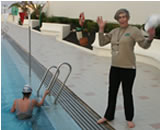Five Clues for Better Swimming
By Stephanie Ellis
 "My teaching is heavily influenced by a number of techniques to help the swimmer become both more at ease in the water and more effective. The main sources for my technique include Terry Laughlin’s Total Immersion method and the Shaw Method (based on the Alexander Technique). Both these techniques enable swimmers to become more at home in the water and to swim more easily. My approach is very pragmatic and practical and is based upon simple physics." Speed in the water is influenced by two important factors: the power that you can put in, and how effective you are at reducing drag. My teaching puts a great deal of focus on the latter: on making you helping you to work with the water and slide through it. Here is a list of the really important clues that tell you how well you are swimming.
"My teaching is heavily influenced by a number of techniques to help the swimmer become both more at ease in the water and more effective. The main sources for my technique include Terry Laughlin’s Total Immersion method and the Shaw Method (based on the Alexander Technique). Both these techniques enable swimmers to become more at home in the water and to swim more easily. My approach is very pragmatic and practical and is based upon simple physics." Speed in the water is influenced by two important factors: the power that you can put in, and how effective you are at reducing drag. My teaching puts a great deal of focus on the latter: on making you helping you to work with the water and slide through it. Here is a list of the really important clues that tell you how well you are swimming.
One – The noise you make
One of the easiest ways of telling how well you are swimming is to listen to yourself. If you can hear yourself splashing or gasping for breath these are powerful messages that you are not swimming effectively. Splashing wastes energy – energy that should be used to helping you get to where you want when you want. Gasping for breath is also a sure sign that you are burning up oxygen and energy faster than you need. The short term solution is to slow down and concentrate on making the stroke more fluid. The longer term solution is to work on getting the stroke right.
Two – What you do with your head
The head-neck-back relationship is pretty difficult to detect on your own. A grossly oversimplified way of describing this is to say that if you lift your head (either to breath, or to see where you are going) your body is likely to have to move in a position that increases drag. If you experiment with trying to avoid lifting your head you may well come to the conclusion that it is impossible. It is possible once taught right way of moving your head and your body.
Three – Where you legs lie
Watch other swimmers and you will see that many swim with their legs quite low in the water increasing drag. We need to find ways of enabling you to float flat in the water. Start by trying to think of the body as a seesaw: the head and the legs are solid but the legs are longer than the head and so pull you down more. There are two ways of sorting this out: shorten the legs or press down more on the other side of the seesaw.
Four – Are you swimming on your front, back or side?
This is another aspect of your body position. Many people assume that the front crawl and back crawl mean that you swim flat on your front or flat on your back. I will teach you to swim both these strokes with a greater emphasis on swimming on your side.
Five – How do you feel about breathing?
Ask anyone learning to swim what the most difficult thing is and more often than not they will say breathing. This is perhaps the most misunderstood and most anxiety provoking area of swimming. The answer is however to do less, to slow down, to relax, to only put just enough work in and all of a sudden you will find that breathing stops being the big problem. I could, and probably will, write essays on breathing but for now the best advice is to slow down, get the breathing right, and then gradually (ever so gradually: most people try to go fast much too early) build up the speed.
There you are – five simple clues as to how well you are swimming. What more could you possibly want? Well, if it came down to just 5 clues and you could swim better by reading, you are now an expert swimmer! For mere mortals, I can coach you to get the most out of these clues along with a host of others.
For more information please contact Stephanie.
